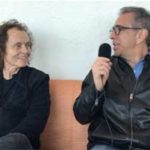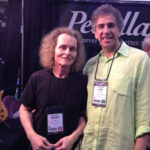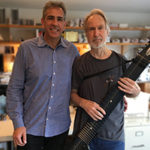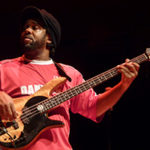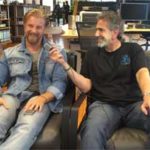Fretless master releases stunning new duo recording with drummer Danny Gottlieb
Exclusive interview with FBPO’s Jon Liebman
September 7, 2020
Photo: Florian Reider
Mark Egan is a Grammy-winning bassist who’s performed and recorded with an extraordinarily diverse roster of artists, including everyone from David Sanborn, John McLaughlin, and Larry Coryell to Carly Simon, Cyndi Lauper, Sting, Joan Osborne and Duran Duran. Mark’s bass can also be heard on many movies and TV shows, including Aladdin, The Color of Money, A Chorus Line, CNN Headline News, NBC Sports, and All My Children.
Widely known for his tenure with the Pat Metheny band and Gil Evans Orchestra, Mark is also a bandleader and solo artist in his own right. I had a chance to speak with him about his latest project, a compilation with his longtime friend and collaborator Danny Gottlieb, with whom he’s performed for nearly fifty years. The duo’s new release, Electric Blue, was released this month on Egan’s independent label, Wavetone Records.
FBPO: When you and Danny recorded this album, were you actually in a room together?
Mark: Yes, we recorded this last winter, of ‘19. And I had my studio in Connecticut. It’s called Electric Fields Studio. We got together for four days and we sort of charted out the territory that we wanted to explore. That was basically the basic way that we did it.
FBPO: Did you have anything in mind before you got together or did you just say, “Let’s get in a room and see what happens?”
Mark: We had a lot in mind, actually. We had been talking about it and sort of scheming beforehand. We sketched out the peaks and valleys of the moods that we wanted to do and picked up different key centers, so everything wasn’t in the same key and the same tempo. We wanted to make something that was not just a drum and in bass feature, but something that flowed, something you could listen to. That was our goal.
FBPO: You and Danny have been playing and recording together forever. How were you still able to come up with something altogether new after all these years?
Mark: Yes, Danny and I have been playing together almost 50 years. We first met at the University of Miami, your alma mater as well. And we always have had a special rapport when we got together just to play duo. We would just do jams and it always had a musical sense to it, more than just sounding like drums and bass. We would complement each other. It’s a real intuitive type of glue that we have together that makes it work. It’s hard to describe, but we’ve played in so many different rhythm sections together beyond, obviously, Pat Metheny Group, but with Gil Evans Orchestra for many years, and Pat Martino, Larry Coryell, and many others. I can’t even name all the different types of rhythm section scenarios that we’ve been in, but we carry things, and have always gotten things from that. It’s always very fresh when we play. Sometimes we don’t know where it’s going to go, but in the case of this record, Electric Blue, we had some specific areas that we wanted to cover, as far as tempos and moods. On some of the tracks, like the title track, Electric Blue, pretty much we played just duo, but then Danny added shakers on it. And then there’s another track called Cabareté, a Latin tune, and Danny also played some shakers in that. There’s sort of a balance between multi-layered overdubbed basses and percussion to just more of a bare drums and bass. It was a little bit of overdubs.
FBPO: Even with the overdubs, it’s amazing how much music can be made with just bass and drums. This record sounds like a whole band. How do you approach outlining the harmony while also providing the melody and improvisation and laying down a bass line? How do you reconcile all those things?
Mark: Well, for instance, the first track, “Back and Forth,” that was a track that Danny put down a whole drum track of a groove. We wanted to just feature the drums on playing sort of a “jungly” type of groove. I think he had two tracks of two drum sets, so one drum set then another one, and then percussion on top of that. That was interesting because I had this form, I had the length of the piece, which is four or five minutes and I use the Fibonacci series. Are you familiar with that?
FBPO: That was going to be one of my upcoming questions, the Golden Ratio, Fibonacci sequence. How in the world did you take a deep mathematical formula like that and make it sound so musical?
Mark: Right. Well, that Golden Ratio is 1.618. I knew what the tempo was and I knew how long the piece was. If you look at it sort of on a graph, we have the beginning and the end. So I took the time of it, and I multiplied times 1.618, and that breaks everything into two sections. And then if you apply that same ratio to each of those sections, that chops that into another section and the other into another section. So I had four different things and you can keep dividing and keep doing those. And that ratio happens within all of that. The amazing thing was that Danny changed his drum parts, unbeknownst to (the fact) that I was going to later super impose the Fibonacci series on top of it. Then I plugged in different chords at those different places, and it would recapitalize at the end. So that’s basically the structure of that. Once the chords were in place, I played a bass line. After the bass line was on, I added a second bass part up in the higher range of the bass to sound more like a guitar that has chorus on it. And then I doubled those parts with sevenths and thirds, or tenths and thirds, and that gave it more of a comping point of view. And then I soloed it on top of that and played melodies. And that’s how that particular song came about.
FBPO: And it sounds great. You know, I’ve done almost 700 interviews, and this is the first time the Fibonacci sequence has ever come up in any of them.
Mark: [Laughs] Great!
FBPO: This album has so many different grooves and feels, yet it’s still very cohesive. “Hookey,” for example, is totally at the other end of the spectrum from “Back and Forth.”
Mark: Yes, it is. That was a little thing we put together in the studio. It’s just, like a little punky, rocky thing that we wanted to have fun with. It’s a short piece, it’s just drums and bass, no overdubs.
FBPO: I love the interplay over the repetitive groove on the title track, “Electric Blue.” Most of it sounds like a drum solo enhanced by a bass groove that sets the foundation. Would you agree with that?
Mark: Totally. That’s exactly what it is. I wanted Danny to go, and it started as rubato and then went into the groove and those chords and I just wanted to lay it down for Danny. I thought it was a perfect vehicle because he played so great on it.
FBPO: I know he studied with Joe Morello and I wonder if that’s where he got some of the inspiration for this tune. I kept thinking of Joe on Brubeck’s “Take Five.” It’s kind of a different context, but it’s conceptually sort of parallel.
Mark: Yes. It’s so true. And Danny has amazing facility on the drums. Yes, he did study with Joe. Joe was his mentor for many years until Joe passed away. And a lot of people don’t realize the rock side of Danny because Danny played with the new Mahavishnu Orchestra with John McLaughlin, and so that’s sort of a taste of where Danny can go with that on the “Electric Blue” track at the end. And that’s the beauty of playing with Danny is he has amazing facility in his has hands and feet, and he can play anything. Sometimes if I’m playing a half-time groove, he might double up or triple the time up because he has this facility. It’s a really expanded concept and that inspires me to play differently as well. That’s why we love playing duo together so much because so much can happen.
FBPO: You’ve spoken in the past about the importance of groove, especially when it comes to bass and drums playing together. The importance of groove should be obvious, but it can never be taken for granted. Can you share some thoughts on that?
Mark: Oh sure. You know, the groove can never be taken for granted. Bass is such an important part of the foundation of music, to me. My upbringing comes from listening to Motown music and Cream and the Beatles and Led Zeppelin and R&B, just hardcore R&B, James Brown funk, and the groove to me is the starting point, it’s the foundation. And I really came to focus in on that when I started listening to Miles Davis and all the bass players who were playing with him, like Michael Henderson and Dave Holland, but more of the electric players. But just growing up during the time and listening to Tower of Power, James Brown, as I mentioned. I think especially nowadays, so many people have been able to master the technique on the bass. I’m always amazed. If you took a time capsule back in time or a time machine to the NAMM show 30 years ago, or 20 years ago, people didn’t have all these chops on bass. This is all a new phenomenon in the last 20 years, 25 years. I’m not sure exactly the timing of that.
FBPO: The Victor Wootens, the Hadrien Ferauds, the Federico Malamans…
Mark: Exactly. Yes. Right, Jon. And that is all great. And it’s great that it’s evolving and it’s growing. But to me, you can’t leave the groove behind, the groove is the essence of it all. And that’s one of the things when I first met Jaco. I was so impressed with his groove. You know, people don’t always talk about Jaco’s groove, they talk about his virtuoso playing, and how he played all these great solos, but he did it all with the most highly, highly evolved groove. I think that the starting point is the groove and everything should emanate from that. That’s my feeling.
FBPO: I couldn’t agree more.
Mark: Yes. I think that’s the foundation. That’s where the instrument started, and I think anyone who wants to be a bass player really has to get that under their belt. And that really hit home when I moved to New York and realized that if you wanted to work in the sessions and do studio work in New York, you had to have a ridiculously solid groove because there were people laying it down. So that’s where it really became obvious for me, in the studio, and hearing it back, and working on it and trying to make it better.
FBPO: Absolutely. Tell me about your gear.
Mark: I’m still playing Pedulla basses. I’ve been a Pedulla player for, gosh, 40 years. I’m playing D’Addario strings, XL 170s. For amplifiers I’m playing MarkBass amps, a wide array of different ones from the 12-inch cabinets combos to the self-powered separate amps. The Big Bang it’s called, which is a nice, smaller amp and it’s really portable. I play through Radial direct boxes, the JDI direct boxes.
FBPO: I heard, more than once, some “sub E” notes on this record. You played some 5-string or 6-string fretless basses?
Mark: Yes. On this record, I play 5-string fretted and 5-string fretless. I also play my double-neck on this. My double-neck has a 4-string fretless and an 8-string fretted.
FBPO: Everything is Pedulla? All your basses?
Mark: On this record, everything is Pedulla. I have a Marleaux bass, do you know Marleaux?
FBPO: Gerald! Yeah. Great guy.
Mark: Great guy. Really fantastic builder. He’s really great.
FBPO: Yeah. Hard worker.
Mark: Hard worker, great man. And I have two of his basses. I have a Consat and a Votan DX Deluxe. Yeah. Those are 5-strings.
FBPO: Not to bring you down, Mark, but I wondered if you want to say anything about Lyle Mays.
Mark: Oh yeah. That was sad. We lost Lyle. No, it doesn’t bring me down. I’m so fortunate to have been in the Pat Metheny group with Lyle. And I’ve been around his presence, for me for four years, playing with Lyle. And he was such a great musician and such a great person. He’s just greatly missed. And people don’t realize how much a part of the Pat Metheny group sound, at least of that particular band, the early band, that we did those two records, American Garage and the so-called White Album. Lyle was a true genius and his orchestration abilities were really a big part of the sound of that band. And his playing! He was a virtuoso player. It was really an incredible experience being around him. I hadn’t seen him that much since I left the band, but we were in touch. I hadn’t been in touch with him as of the last five years, and I was just very saddened that we lost him, but he sure gave us a lot of great music and he’ll always have a place in my heart.
FBPO: What advice can you impart to someone who wants to learn bass? What do you think is important for them to know?
Mark: First, I think, is learning the basics of the instrument, to get with a good teacher who can guide you along. When I started to play bass, I listened to records on the radio. I went out and just bought a bass because I loved it. And I would listen to records and learn bass lines off of records. So the main thing is to be really open and not to think that, you know everything. [Laughs] You know what I mean, Jon?
FBPO: I do.
Mark: You have a lot of students. Is it one-to-one, or is it a group?
FBPO: At For Bass Players Only, we’ve got members in just about every state and about 50 countries. Once they subscribe, they just log in and all the lessons and courses are available to them. I always encourage members to reach out to me if they have questions or if they get hung up on a fingering, a hand position, a shift, or anything at all. I enjoy hearing from my students and helping them learn bass.
Mark: But you know, another thing that I would suggest to people that are starting to play is to really investigate and find out who the real mainstream players are of each type of music. Like for funk, find out about James Jamerson. Go back to the grandfathers of the instrument that really made a statement. Go to the source, as opposed to going to like fourth or fifth generation of some modern bands today that really liked the way those guys played. If they really studied and realized that it came from studying the lineage of the instrument. Once I started to realize where this music came from, I went back and studied with the masters.
FBPO: I think that’s a very good point, but I also think there’s something to be said about the people who took what the grandfathers came up with and built on it, taking it to the next level. I was at Emmett Chapman’s house a couple of years ago, for example, and I got to learn about his history and his story first-hand. And it turned out that some of the guys that picked up the instrument ended up doing things on the stick that Emmett had never even conceived of. They just took it to a whole different level. I agree wholeheartedly with what you’re saying, but I also think you can get the best of both worlds by seeing what players one or two generations later came up with based on what the founding fathers did initially.
Mark: Yeah. I agree with what you’re saying. Absolutely. I was thinking more in terms of the groove, as opposed a whole new way of playing. If you listen to someone in a band who was playing a certain groove and then you realize where that really came from, and then you can go back and say, “Oh, Jamerson, Bootsy Collins,” like that stuff.
 FBPO: Great point. So what’s next for you, Mark? You never seem to run out of ideas.
FBPO: Great point. So what’s next for you, Mark? You never seem to run out of ideas.
Mark: [Laughs] Well, I’m working on another record actually. One of my own records. Now I’m starting to write music for another solo record. Not solo solo, but a solo group record. So I’ve been in the composition mode right now. Also, Danny and I have more music that we recorded that we’ll probably produce into another record that’ll come out probably in a year or two. I haven’t been touring as most musicians have not been touring, but when this does break, COVID, I hope to go on, continue traveling to Europe and playing in Europe and playing in the States.
FBPO: With who? With your own band?
Mark: With my own band. Danny and I had planned to do a duo tour for this present record, Electric Blue, but obviously we had to shelve that. But we’re going to try to book some dates when things do open up. I also play in Europe. I might’ve mentioned this to you, Jon, in Austria. It’s a festival called Outreach. And it’s a week of festivals, which was canceled. Actually, they had it this year, but the American guys didn’t go over.
FBPO: Oh, that’s interesting.
Mark: Yeah. It’s a lot of European players in it too. But the American guys from New York and the East didn’t make it over there this year. So I’ll be doing that again, which is also a great thing because I write for a big band for that, which this is the seventh, would have been the eighth year for me doing that.
FBPO: Congratulations again on the new recording. We’ll all look forward to seeing what you come up with next.
Mark: I’m just glad that Danny and I were able to record this duo record and to document our legacy as a rhythm section. We’ve been wanting to do a whole record of it for a long time. We’ve done duos on each other’s records, but we never did a whole record of it. So I’m glad that we were able to do that.
See Jon’s blog, with key takeaways from this interview, here.
Electric Blue is available here.


